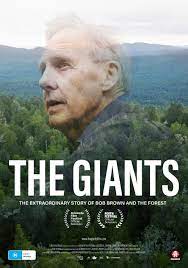
THE GIANTS
Australia, 2023, 113 minutes, Colour.
Directed by Rachel Antony, Laurence Billiet.
The giants of the title are trees. And, initially and right throughout the film, the camera focuses on extraordinary trees, extraordinary tall trees, Huon Pines, Eucalypts, Tasmanian Myrtles, lichen, algae, especially in the Tasmanian forests and, most especially, in the Tarkine forest. And, throughout the film, there is a range of scientists who open up to us the anatomy of trees, the life and vitality within the trees and on their surfaces, a world which most of us do not take into consideration. And we are invited to look at these trees with wonder.
And, to add to our awareness and knowledge, cinematic technology comes to our aid, three-dimensional photography of trees, computerised, animation PowerPoint material with technology charts, charts of growth and development, all instructive and fascinating.
Poet Joyce Kilmer once wrote: I think that I shall never see a poem lovely as a tree. So, here are trees in all their vitality, majesty, loveliness, ancient, taller than the dinosaurs, monuments to creative evolution. But – and this is the dynamic and thrust of the film – they are continually under threat from damming, loggers, woodchip industries, development decisions, with Australia under criticism.
But, the main giant focus of this documentary is Dr Bob Brown, longtime environmentalist, campaigner, politician, senator. In many ways, this is a feature-length portrait of him, a version of “Where Do You Think You Come from?”.
In fact, this is a very interesting cinema portrait of Bob Brown himself, on-screen frequently in family movie clips from the past, television interviews, television episodes of his campaigns, Parliamentary speeches, building up a portrait of him in the past. And, in his late 70s, he is also centre screen during the documentary, revisiting his past, literally going back to important locations from the past, especially the Franklin River.
Audiences with long memories will go back to the 1970s, the Tasmanian governments damming of the pristine Lake Pedder, the 1980s campaign against the damming of the Franklin River, Peter Dombrovskis’ classic photo of the River in the campaign, Bob Hawke stepping in, the decision of the High Court against the damming. Along with the many scenes of Bob Brown himself, there is also Karen Alexander of the Tasmanian Wilderness Society, highly praised by Brown for her commitment and activity.
But all this is set within quite a detailed look into Bob Brown’s personal life, a lot of commentary from his twin sister, Jan. There is a tribute to his policeman father, to his mother, quite a lot of detail about his growing up, interest in nature, his high schooling (and an episode of being sexually molested by a teacher), his University studies, medicine, surgery and Launceston.
And, many will realise that there is the extra dimension in this portrait of Bob Brown, his sexual orientation, his coming out in the late 1970s, courageous at the time, abuse from many combined with their abuse at his being a greenie. There are scenes of campaigner, Rodney Croom, and the change of legislation in Tasmania. The film shows how Bob Brown came to terms with this reality of his life, coming to an acceptance and peace, some scenes with his partner, Paul Thomas.
Which means that there is a great deal going on in this documentary. The Who Do You Think You Come From? aspect could have been a film in itself. The appeal to care for the environment, the campaigning, the episodes, the formation of the Australian Greens, the environmental career of Bob Brown could also be a film in itself.
And, all the way through, we return to the forests, to the trees, to growth, to heritage protection, to vistas of logging and devastation, continually relevant and challenging as we watch this film in the 2020s.